People around the world name budgies by origin, country, size, color, etc. names accordingly. For example, wild, normal, American, Australian, and English budgies.
As a result, we sometimes call the same group of budgies by different names today. However, this kind of naming of budgies can confuse people trying to learn about the budgerigar world.
Quick comparison table for English, Australian, American vs. wild, and normal budgies.
| Origin | Lifespan | Size | Weight | |
|---|---|---|---|---|
| Wild budgies | Australia | 5-8 Years | 7 inches (ca. 18 cm) | 1.1–1.4 oz (ca. 30–40 gr) |
| English budgies | Australia | 5-7 Years | 9 inches (ca. 23 cm) | 1.6–2.2 oz (ca. 60–83 gr) |
| Show (Exhibition) budgies | Australia | 5-7 Years | 9 inches (ca. 23 cm) | 1.6–2.2 oz (ca. 60–83 gr) |
| Australian budgies | Australia | 5-8 Years | 7 inches (ca. 18 cm) | 1.1–1.4 oz (ca. 30–40 gr) |
| American budgies | Australia | 7-12 Years | 7 inches (ca. 18 cm) | 1.1–1.4 oz (ca. 30–40 gr) |
| Normal budgies | Australia | 7-12 Years | 7 inches (ca. 18 cm) | 1.1–1.4 oz (ca. 30–40 gr) |
What are wild budgies? Wild budgies refer to budgies that live in Australia in nature. It is a population of budgies without human influence.
What are Australian budgies? Australian budgies refer to budgies that live in Australia in nature. Besides, “Australian budgies” almost always refers to wild budgies around the world.
What are normal budgies? Normal budgies refer to budgies that live all around the world and have a similar size as wild budgies. Besides, normal budgies may have all kinds of mutations and varieties.
What are American budgies? American budgies refer to the population of normal-like budgies that live in America. They may have all kinds of mutations and varieties.
What are English budgies? English budgies refer to the budgies that have arisen by selective breeding and are much larger than wild budgies. These budgies live all around the world today. In addition, they may have all kinds of mutations and varieties.
What are show (exhibition) budgies? Exhibition budgies refer to a special group of budgies that are produced for exhibitions, competitions, and shows. Show budgies are often bred from English budgies to be large. But there are also small-sized show (exhibition) budgies.
In addition, we need to know a bit about the history and mutations of budgies to understand why there are so many varieties.
We will henceforth call wild budgies “wild (Australian) budgies”, normal budgies “normal and American budgies” or “normal or American budgies”. Because they often refer to the same species and group of budgies.
Origin & History
The origin of the budgie species is the continent of Australia. Budgies were first reported in 1805.
Today, budgies survive in the harsh climatic conditions of Australia without any problems. Most budgies living in the wild in Australia are green, yellow, and black. We call them “wild budgies”.
It is thought that wild budgerigars were first brought to England from Australia in the 1840s. In later times, people continued to take wild budgies out of Australia continuously to their home countries.
The first reported budgies were wild budgies, and humans often didn’t encounter the budgie colors and varieties such as blue, albino, lutino, or crested as we see today.
How the First English Budgies Appeared?
Budgie breeders in England took a particular route in breeding wild budgerigars in the late 1800s and early 1900s. They used selective breeding to breed budgerigars. British budgie breeders have used selective breeding, regularly selecting larger budgies in each generation.
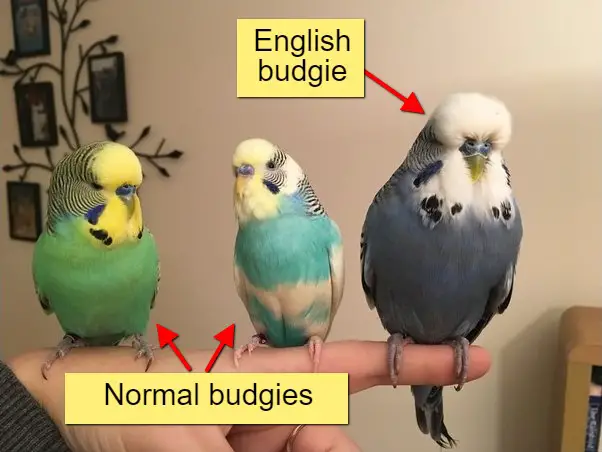
As a result, the budgie population in and around England got larger sized than wild budgies. This is a basic explanation of how “English budgies” came to be today.
In addition, budgerigar breeders have never stopped selective breeding to date. They also continued selective breeding, passing on rare and beautiful-looking traits from generation to generation. For example, longer feathers, larger throat spots, rare color combinations, and rare mutations.
Besides the English budgie, budgie breeders usually organize competitions and shows with the budgerigars they breed from English budgies. These budgies are special and called “Show budgies” (exhibition budgies.)
With budgerigars gradually becoming popular around the world, different mutations and variations began to emerge. We see different color budgies, even if they are not large as English budgies.
Today, with the contribution of genetics, we are constantly encountering new color and shape mutations in budgerigars.
Mutations
Selective breeding and genetics have facilitated the production and transmission of mutations in budgies. Today, there are more than 32 budgie mutations reported all over the world.
Besides, budgie breeders often produce new varieties worldwide by combining the mutations.
Lifespan
Wild (Australian) budgies have a lifespan of 5 to 8 years. Besides, normal and American budgies have a lifespan of 7 to 12 years.
This lifetime varies according to many factors. Because captive budgies are better fed and cared for, they have a longer lifespan than wild (Australian) budgies.
On the other hand, English and show (exhibition) budgies may have a shorter lifespan than other budgies due to certain diseases such as tumors and weight gain, brought on by years of selective breeding. English and show (exhibition) budgies have a lifespan of 5 to 7 years.
Size
The body size of wild (Australian), normal, and American budgies is about 7 inches (ca. 18 cm). Besides, the body size of English and show (exhibition) budgies is about 9 inches (ca. 23 cm).
Weight
The body weight of wild (Australian), normal, and American budgies is between 1.1–1.4 oz (ca. 30–40 g). Besides, The body weight of English and show (exhibition) is between 1.6 oz (ca. 60 g) to 2.2 oz (ca. 83 g).
Appearance
Wild (Australian) budgies have the most knows colors in the budgerigar world. A wild budgie is often green, yellow, and black.
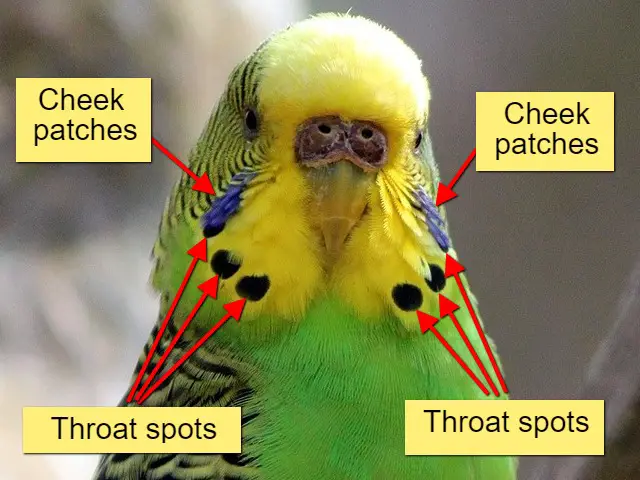
The video below shows a flock of budgies that all members are the same color and size.
Normal, American, English, and show (exhibition) budgies have been produced by selective breeding for over a century. For this reason, budgies have numerous varieties emerged until today.
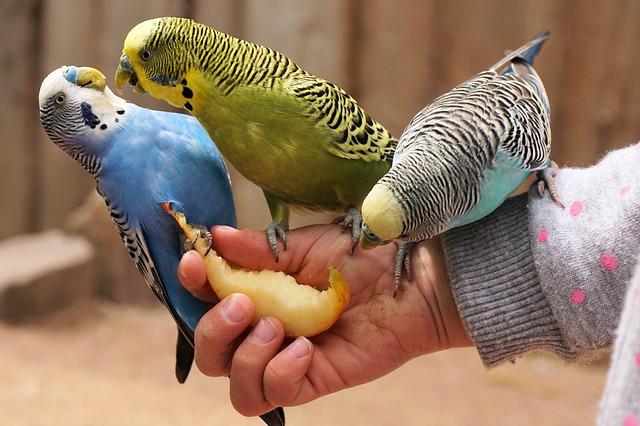
Any type of budgerigar can have any mutation or color. However, due to selective breeding, certain budgies, such as show (exhibition) budgies, have improved body parts such as cheek patches and throat spots.
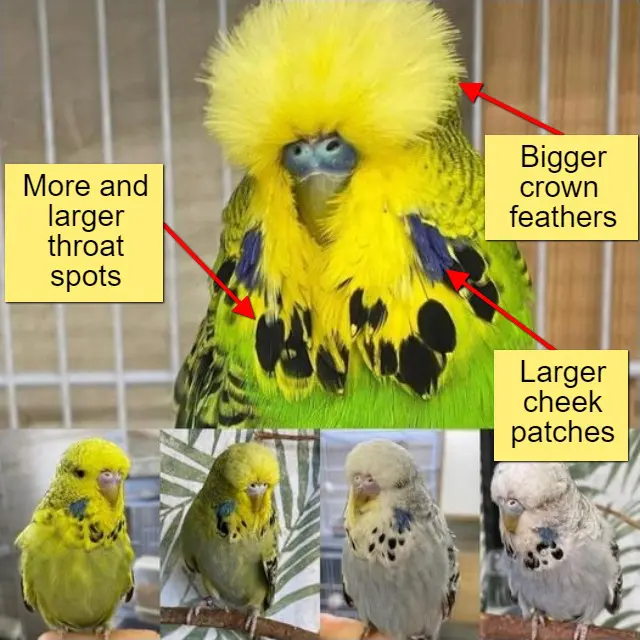
Cheek Patches
Wild (Australian) budgies have regular-sized violet-colored cheek patches. Besides, budgies other than wild budgies may have gray, silvery, white, or yellow cheek patches or no cheek patches.
Throat Spots
Wild (Australian) budgies have six black throat spots. Normal, American, and English budgies also usually have six throat spots. Show (exhibition) budgies have often more than six and larger throat spots.
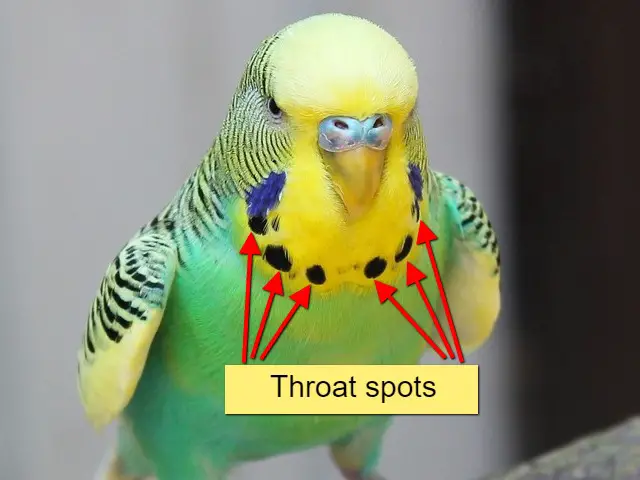
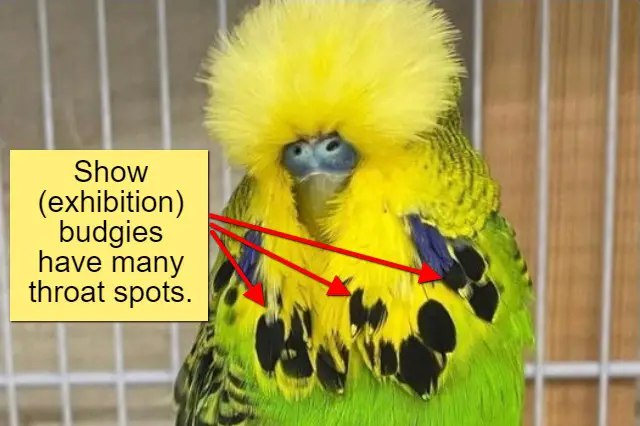
Budgies other than wild (Australian) budgies can have gray, white, and silver throat spots. No other colored throat spots were observed in wild (Australian) budgies other than black throat spots.
In addition, some mutations eliminate throat spots completely, such as spangle mutation.

But keep in mind that any budgie may have spangle mutation.
Colors
Wild (Australian) budgies are usually green, yellow, and black.
Character
Australian (wild) budgies are extremely social creatures. In nature, they live in flocks. They are always in communication in multiple ways with their mates and other budgies all the time.
Talking
Wild (Australian), normal, American, English, show (exhibition) budgies can talk. Mimic ability is a feature that exists in all members of the budgerigar species. All budgies mimic the sounds, human talking, and body gestures.
In addition, budgies such as English budgies and show (exhibition) budgies may prefer to talk less because of their large bodies and chronic conditions. However, this is not always the case.
Noise
All budgies are noisy. But, budgies such as English budgies and show (exhibition) budgies may not be as active and lively as normal budgies. They usually make less noise.
Health
Health in budgies depends on many factors. But, it is well-known that selective breeding methods give budgies many unpredictable diseases. So, this situation is the same in all kinds of budgies.
But, when it comes to larger size budgies such as English and show budgies, the larger size becomes a problem. For, example, due to the size of English budgies, they are typically less active budgies.
Tumor formation is frequently observed in the body of English and show budgies due to their low mobility and selective breeding.
Care (Bathing & Cage Cleaning)
Caring, bathing, and cage cleaning of budgerigars do not change according to their breed or hometown.
Diet
Wild (Australian) budgies eat numerous seeds, insects, greens, and fruits in nature.
English, show, normal, American budgies also can eat what wild budgies eat in nature.
Besides, English budgies need more attention when it comes to nutrition. They require more nutritious foods, due to their lack of mobility.
Show (exhibition) budgies are the group of budgies that are given the most attention to feed. Because, exhibition budgie breeders always feed their show budgies with the best seeds for health and healthy reproduction in the market.
Training & Exercise
Normal, American, and English budgies are typically easier to train and do daily exercises.
Budgie owners should pay more attention to the daily exercise of their English budgie than other budgies. English budgies do not prefer to be active like normal budgies.
Show (exhibition) budgies are less active than any other budgie. Both their larger size and selective breeding make them calm and immobile. Due to their inactivity, it is difficult for them to exercise. The lack of mobility also makes them difficult to train.
Toys
All budgies like to play with toys. Toy selections do not change according to their kind.
Price & Daily Cost
Normal, American, wild budgie prices typically are between $10 to $35 worldwide.
English and show budgie prices are generally between $50 to $90 worldwide.
In addition, a budgie may have a higher price tag depending on the mutations it has. There is no up limit when it comes to special and rare budgies.
On the other hand, as a group of budgies, show (exhibition) budgies often have higher price tags. They already have special and rare mutations.
For example, in 1988 a real show budgie sold for 2,500 GBP. That makes about at least 7,150 GBP ($8,770) after 2022 with inflation calculated.
Yes, English budgies and American budgies can live together without any problem. English budgies are larger but slower than American budgies. There will be a relationship with each other in the same way they get along with any other budgie. But, when it comes to breeding, due to the size of English budgies American budgie males may have difficulties mating with English female budgies.
The main differences between English and regular budgies are size and health. English budgies are larger than regular budgies. In addition, due to selective breeding, English budgies are more likely to encounter health problems such as tumors. Normal budgies are comparatively healthier than English budgies.


![Exhibition (show) budgies [Photos, Lifespan, Breeding, Care]](https://www.petiska.com/wp-content/uploads/2022/05/exhibition-show-budgies-photos-lifespan-breeding-care-1652287918-400x300.jpg)